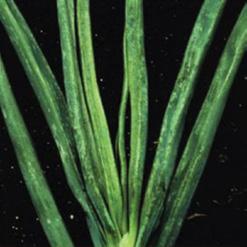
4 minute read
Onion thrips (Thysanoptera: Thripidae
Onion thrips
(Thysanoptera: Thripidae)
Thrips tabaci, onions thrips, is common in South Africa. It is indigenous to eastern Mediterranean, which is the center of origin of onions, the most important host plant of onion thrips.
Nozibusiso Maphumulo
IPM-PROGRAMME, NORTH-WEST UNIVERSITY, POTCHEFSTROOM
Onion thrips classification:
Class: Insecta (Insects) Order: Thysanoptera (thrips) Family: Thripidae Genus: Thrips Species: tabaci
It is now worldwide distributed in Europe, North America, South America, Africa (including South Africa), Asia and Australia. Onion thrips have a wide range of host plants in comparison to other thrips species. Vegetable host plants of onion thrips include onions, asparagus, cabbage, cauliflower, beans, garlic, lettuce, leek, peas, potatoes, spinach and tomatoes. Other hosts of onions thrips are apple, fig, orange, plum, peach, cotton, tobacco, clover, wheat, lucerne, lupin and pasture grass.
The eggs of onion thrips are white or yellow in colour, kidney shaped and are microscopic with the size of approximately 0,26 mm. The larvae of onion thrips are difficult to distinguish from the larvae of other thrips species. However, it can be distinguished from other thrips species by having the shortest macrosetae and the absence of dark grey chitinous markings on the dorsum of the thorax. The 1st instar is smaller with the length of 0,35-0,38 mm. It is semi-transparent and dull white, and changes to yellowish white at a later stage. The 2nd instar is bigger and yellow in colour with red eyes and a length of 0,7-0,9 mm. The prepupa and pupa of onion thrips is distinguishable from the larvae by the presence of wing sheaths. Another distinguishing feature of the prepupa and pupa from the larvae is the development and orientation of antennae and the size of the antennae and wing sheaths. Prepupa is 0,9 mm in length and 0,23 mm in width with whitish-yellow colour. Pupae are yellowish-white and changes to yellow before adult emergence.
Adult onion thrips vary in colour from pale yellow to dark brown depending on temperature during their development. Adults that develop quickly during summer or at high temperatures are usually smaller and paler than those that develop slowly during winter or at low temperatures. Males are smaller and paler than females. The body colour and size of adult onion thrips are determined by temperature during the pupal and larval stages. Adults are elongated with females having a body length of 1,0–1,3 mm while males are ≈ 0,7 mm. Adult longevity ranges from 28 to 30 days on onions.

Figure 1. Damage of onion thrips on onion leaves (left) and several onion thrips adults and nymphs on an onion leaf (right).
Source: https://hort.extension.wisc.edu/articles/onion-thrips/

Figure 2. Adult onion thrips female on an onion leaf.
Source: https://hort.extension.wisc.edu/articles/onion-thrips/
The life cycle of onion thrips comprises of egg, 1st and 2nd larval instars, prepupa, pupa and adult stage. Females have a one week preoviposition period and can lay eggs for the duration of three weeks. Eggs are deposited singly either on the upper or lower surface of a leaf near to the surface and are always deposited diagonally. Eggs hatch within 5 to10 days under cooler environmental conditions. The duration of the 1st instar ranges from 2 to 3 days, while the 2nd instar ranges from 3 to 4 days. Pupation occurs at the base of the onion’s apical meristem or within the soil and ranges between 3 to 10 days. Onion thrips reproduce both sexually and asexually. It is one of the few species of thrips that reproduce through parthenogenesis (asexually), which is the production of offspring without fertilization by a male. Onion thrips usually overwinter as adults in the soil.
Onion thrips has become a pest of increasing concern on commercial onions globally, and it is a difficult pest to control on onions. This is due to their ability to develop resistance to insecticides, transmit plant pathogens, and produce more generations at high temperatures. Onion thrips leads to both direct and indirect damage to onions by feeding and ovipositing on leaves resulting in unmarketable green onions and reduced size of dry onion bulb. The 1st and 2nd instar larvae are active feeding stages. Feeding directly on the leaves, results in blotches and premature senescence as well as distorted and small bulbs. Plants that are heavily infested grow slow and remain small while leaves show a silvery-white sheen. Leaves that suffered serious damage become curly and crinkled. Immature and mature onion thrips can be observed by separating young leaves of onion plants. Onion thrips reduces the yield of onions and garlic. They also affect stored onions and garlic. Yield loss caused by onion thrips on onions can be >50%. Onion thrips feed and shelter between the leaf scales of onion, thereby, reducing the quality of bulbs and shortening storage life of onions. High populations of onion thrips are favored by environmental stresses such as drought, insufficient nutrition, or alkaline soils.
Onion thrips can be managed through chemical, biological, cultural control and host resistance. Insecticides that are registered to control thrips are organophosphates, chlorinated carbohydrates and pyrethroids.
Enquiries: mashimanenozi03@gmail.com.










